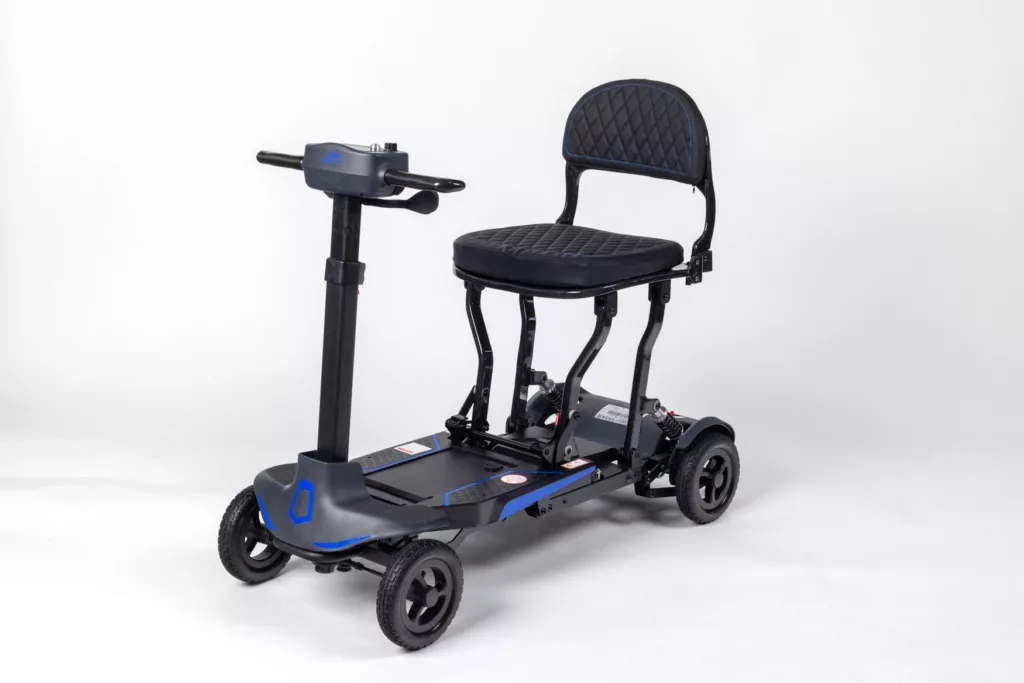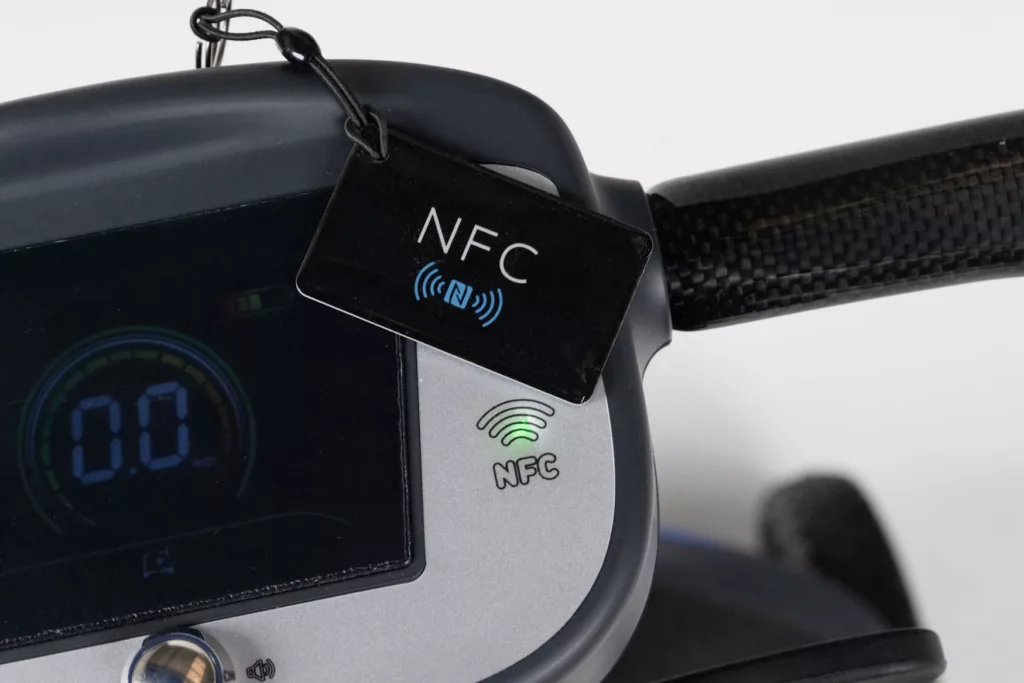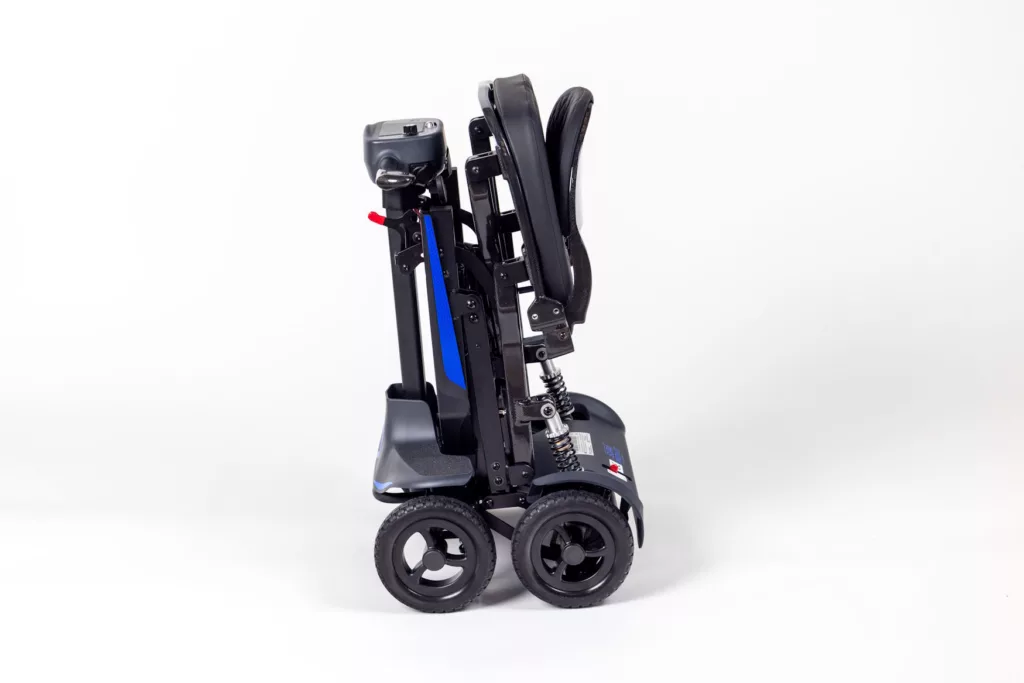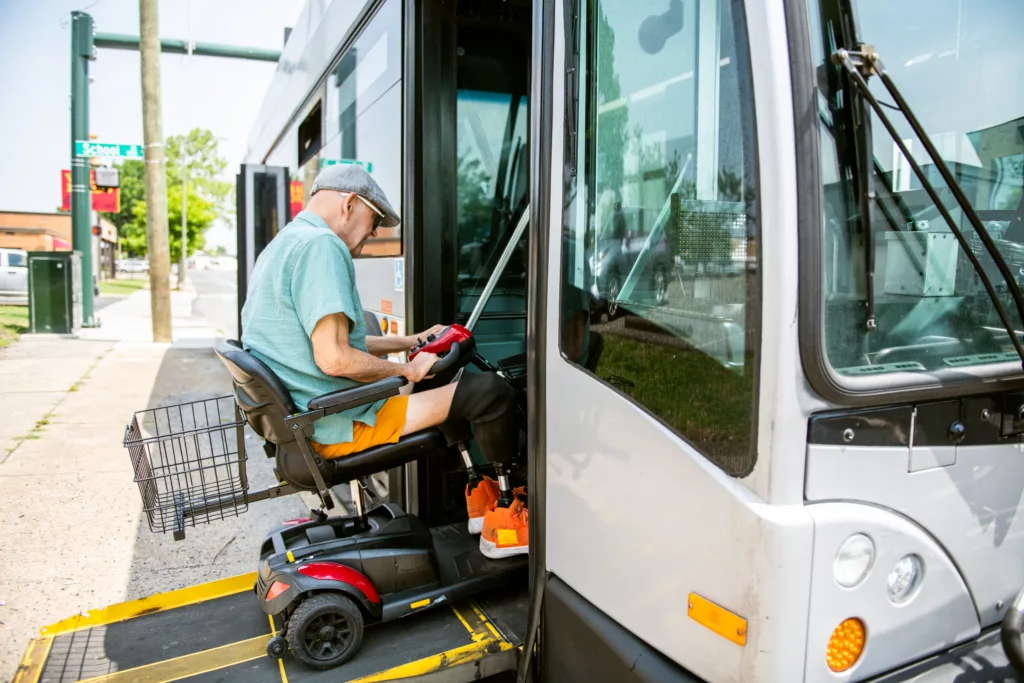Heading out on a mobility scooter should open up new opportunities to socialise, shop, explore, and enjoy your independence. However, there are some key safety tips to keep in mind to protect both yourself and your scooter and avoid any mobility scooters accidents.
Here are our top tips for mobility scooter safety:
If you’re new to using a mobility scooter – or are switching to a different model – it’s essential to get to know how it works before you head out. Test the controls, see how it handles, and learn how fast it can go. The more confident you are with handling your mobility scooter, the safer you’ll feel when you’re out and about.
If you’re heading somewhere new, it’s helpful to find out in advance if there are any narrow paths, steep hills or unusual obstacles that you may need to navigate.
One question we often get asked is “Can mobility scooters topple over?”. The answer is yes they can! Indeed one of the most common causes of injury is caused by going over steep kerbs and tipping over. To avoid this, use dropped kerbs where possible and make sure that you approach kerbs head-on.
Travelling by public transport? Read our guide to using your mobility scooter on the bus, train or tube.
Before you leave home, make sure your battery has sufficient charge and will safely take you to your destination and back again.
Want more battery care tips? Check out our mobility scooter battery care blog.
Good planning helps reduce stress and ensures your trip isn’t rushed. Remember to pack some essential items to take with you, including water, any medication, your mobile phone, emergency contact details, and a coat and/or waterproof jacket in case of unpredictable weather.
It’s a good idea to let a friend or neighbour know where you are going and when you are likely to be back, just in case of any unforeseen issues. It’s a small step that can be very helpful in case of an emergency.
Regular maintenance can help keep your scooter safe, comfortable and reliable.
As part of your maintenance routine, give it a good clean, check key components, and schedule a service to catch faults before they become a safety problem.
Whether you are a class 2 or class 3 mobility scooter user it’s important to understand the rules of the road to avoid mobility scooter accidents.
Make sure you focus on your journey without any distractions (such as your mobile phone), stick to the relevant speed limit, always take care around pedestrians, and look both ways when crossing roads.
Make sure you can see and be seen; use lights if there are any on your scooter, and wear hi vis to be more visible – especially on road-legal mobility scooters.
And finally, don’t drink and drive on your mobility scooter!
To keep your mobility scooter from being stolen – and potentially leaving you stranded on your outing – it’s worth investing in a lock, clamp or alarm for your mobility scooter. These small additions can be a big deterrent, especially when your scooter is parked in public places.
Want to know how to keep a mobility scooter safe and secure at home? Take a look at our advice on ways to store your mobility scooter.
In case of any accidents to you or your scooter, it’s worth taking out mobility scooter insurance for peace of mind. While not legally required, it can protect you in case of accidental damage, theft, or public liability. Some policies also offer breakdown assistance, helping you get home safely if your mobility scooter fails mid-journey.
At Monarch Mobility, we know that having a scooter that you feel comfortable and confident driving will make you safer and happier. That’s why we offer free home demos to ensure you’re getting the right product for your lifestyle and needs.
From compact folding scooters to powerful road-ready models, our team is here to help you stay mobile, independent, and safe.
Explore our range online or contact us today to book your free home demonstration.
Looking for inclusive adventures the whole family can enjoy?
With an estimated 48% of the total UK population having some form of limited mobility, planning accessible days out is more important than ever. Whether you or a loved one uses a mobility scooter or wheelchair, there’s no reason to miss out on a memorable day trip.
At Monarch Mobility, we believe in family mobility for all. That’s why we’ve rounded up these brilliant, wheelchair friendly places to visit across England, Wales, Scotland and Northern Ireland – so everyone can enjoy accessible and enjoyable outings.
There are many fantastic venues to visit throughout the UK. We’ve selected 8 of our favourites – from Cornwall to Northern Ireland – that are ideal for accessible days out with family or friends. Remember to check with the venue to see if they offer a disability discount!
If you’re an animal lover, Newquay Zoo is the perfect place to visit, with over 100 of the most rare and endangered species of animal from across the globe.
Newquay Zoo is committed to access for all. From wheelchair hire and assistant dog access to discounted carer tickets, it’s a favourite for days out for disabled people and wildlife lovers alike.

Love American history and culture? Located in Bath, this immersive museum offers blue badge parking, a buggy transfer to the entrance, and scooter hire. Accessible days out at the American Museum & Gardens provide the opportunity to explore heritage exhibitions or stroll through the beautiful gardens.
Explore Welsh history in this fascinating open-air museum near Cardiff. The museum features level paths, accessible toilets, mobility scooter hire, and free entry for carers. St Fagan’s is a great option for relaxed and informative accessible days out for all the family.
If you’re looking for a beautiful botanical escape, RHS Garden Wisley is a fantastic accessible day out for all the family to enjoy. With smooth, wide pathways throughout the gardens, ample blue badge parking, and accessible toilet facilities, it’s ideal for mobility scooter and wheelchair friendly days out. The glasshouse and visitor centre are also fully accessible, with free wheelchair and mobility scooter hire available on site.

This peaceful garden experience delivers a packed programme of events and activities for everyone. Birmingham Botanical Gardens‘ wide, paved paths, accessible toilets, and wheelchair hire make it ideal for families planning wheelchair friendly days out.
Explore hands-on science with full accessibility. Lifts, level floors, changing facilities, and low counters make the Life Science Centre, one of the best wheelchair friendly places to visit in the North East. Carers go free, and wheelchairs are available on request.
This iconic castle sits atop a hill in the centre of the city. While the historic cobbled terrain can present some challenges, a shuttle service, wheelchair hire, and accessible visitor areas make Edinburgh Castle a surprisingly inclusive destination.

The Titanic Museum is one of Northern Ireland’s most iconic attractions – and has been designed with accessibility in mind. It is fully accessible, with lifts to all floors, accessible toilets, wheelchair hire, and free carer tickets. The interactive exhibits and historic storytelling make this one of the top accessible days out for visitors of all ages.
Whether you’re exploring museums, gardens or castles, your mobility scooter or powerchair should enhance your experience.
A national company, Monarch Mobility provides a wide range of lightweight and foldable mobility aids designed for independence, ease, and comfort.
Wherever your day out takes you, we’re here to support you on your journey. And if you fancy going further afield, why not check out our Top 10 Accessible Cities in Europe?
If you’re planning a UK getaway and need somewhere mobility scooter or wheelchair-friendly, a city break can be the perfect choice.
From ancient cathedrals to coastal promenades, many city centres offer fantastic short holiday destinations for disabled travellers – with accessible attractions, flat routes, and excellent transport links making exploring easier than ever.
Whether you’re exploring solo, with friends or with family, we’ve compiled a list of some of the most accessible city holidays for people with mobility problems. And when you head off, consider a lightweight, foldable mobility scooter to help you navigate these beautiful cities.

Many of Liverpool’s main attractions are located in the Albert Dock. This area is home to several wheelchair accessible museums and galleries – including Tate Liverpool and the Museum of Liverpool – all within short distances of each other. City accessibility is enhanced through its abundance of designated Blue Badge parking spaces, making it a great choice for disabled holidays in England.

As one of the flattest cities in the UK, Norwich is ideal for accessible tours. Its charming medieval streets are easy to navigate, and the city centre is compact, so everything feels close together. It offers plenty of historic landmarks, including the striking Norwich Cathedral, as well as a wide selection of shops and restaurants, many of which have made accessibility upgrades in recent years.

Manchester is a cultural hub, and its infrastructure brilliantly supports wheelchair accessible holidays in the UK. Most of the public transport network – including the Metrolink tram – is fully wheelchair accessible. Don’t miss the Imperial War Museum North or the Science and Industry Museum. The city also offers easy access to National Trust sites just a short drive away – ideal if you want to combine urban exploration with countryside charm.

As one of the most accessible cities in Wales, Cardiff is a fantastic destination. Its relatively flat centre is easy to navigate, and transport links to nearby locations like Swansea and Barry Island make it a great base for exploring. With a rich history, great shopping, and beautiful parks, such as Roath Park and Lake, Cardiff is a top choice for holiday destinations for disabled travellers.

Brighton’s seafront promenade and pier are perfect for mobility scooter users. Although some parts of the city are hilly, the wide, flat paths that follow the coastline allow for easy movement and fabulous sea views. Known for its lively arts scene and independent shops, Brighton offers plenty of activities suitable for those on accessible holidays in the UK.

Despite its ancient heritage, York offers a surprising level of city accessibility, with many attractions built to accommodate mobility scooters and wheelchairs. York Minster and the National Railway Museum both offer a range of accessible features. The city’s compact layout makes it easy to explore without needing to travel far, making it one of the most convenient disabled holiday destinations.

With a rich history and iconic architecture, Oxford is home to many accessible tours and experiences. Several colleges, riverside walks and museums – including the Ashmolean Museum – are mobility scooter friendly, and many public areas offer ramps and lifts for smooth access. It’s a perfect city for anyone looking for a combination of culture and comfort.
Whether you’re after culture, coastlines, or countryside, there are plenty of accessible cities across the UK waiting to be explored. At Monarch Mobility, we believe in making travel easy, enjoyable and inclusive for everyone.
Check out these blogs for more travel ideas with your mobility scooter:
Explore our range of lightweight and folding mobility scooters to help you or your loved ones enjoy smooth, stress-free getaways – or contact our team today for advice and support.
A powerchair offers independence, freedom, and a better quality of life for many. But when it’s time to travel, knowing how to manage power wheelchair transport becomes essential.
Whether you’re heading out for daily errands or planning a longer trip, understanding how to transport your powerchair safely and efficiently is key.
In this article, we’ll explore some practical options for safely lifting a wheelchair into a car.
Some electric wheelchairs are designed to fold or come apart for easier transport. Before you fold or disassemble your power wheelchair for transport, make sure you read the manufacturer’s instructions carefully or watch an online demo to prevent damage.
Most people transport their wheelchair in the boot of a car or van. To do this safely:
Take a look at this article to find out how to take an electric wheelchair on buses and trains.
It’s crucial that you fully secure your powerchair in your car or van to prevent it from moving during sudden stops or accidents, causing injury to passengers or damage to the chair:
When you lift a powerchair into your vehicle, make sure you follow these guidelines to avoid straining your body:
A portable ramp can be a game-changer when transporting heavier electric wheelchair models. Disability ramps are affordable, compact, and easy to use. Alternatively, a car hoist can help lift a powerchair into the car boot.
If you’re yet to buy your powerchair, a folding powerchair could make electric wheelchair transport a lot easier. Most foldable electric wheelchairs automatically fold at the touch of a button, and are more lightweight and compact.
Whatever your needs, Monarch Mobility is here to help you find the right powerchair for your needs.
If a loved one in your family is starting to experience mobility issues, it can be difficult to know how best to help. A mobility scooter for elderly relatives can be a life-changing solution – helping them stay independent, active, and connected with the world around them.
Whether it’s for daily errands, trips to the local shops, appointments, or simply meeting friends for coffee, choosing the right mobility scooter can make a huge difference to their lifestyle – and to your peace of mind.
When choosing a mobility scooter for an elderly parent or family member, it’s important to ask the right questions and consider their individual needs.
Start by thinking about:
If the answer to these is yes, then a scooter could be an ideal choice for promoting family mobility and giving your loved one greater freedom.
Here are a few practical considerations to keep in mind when choosing the best model:

Once you’ve chosen the right mobility scooter for your elderly relative, you’ll also want to look into:

At Monarch Mobility, we know that family mobility is about more than just getting from A to B – it’s about confidence, independence, and peace of mind.
Explore our full range of mobility scooters, or give our friendly team a call to talk through your options. We’ll help you choose the perfect scooter – and can even arrange a free home demo so your loved one can try them in the comfort of their own home.
Monarch Mobility is proud to unveil the Supa Carbon Lite mobility scooter – the lightest Carbon fibre folding scooter in the world – with NFC technology!
Designed with freedom, comfort, and convenience in mind, the Supa Carbon Lite is the perfect ultra-lightweight companion for everyday outings or adventures further afield.
Weighing just 13kg, the Supa Carbon Lite mobility scooter is crafted from carbon fibre, offering unmatched strength and durability without the bulk. Its lightweight frame makes handling and transport effortless, without compromising on reliability.

Despite its lightweight frame, the Supa Carbon Lite doesn’t compromise on comfort. Full suspension, a padded seat, and adjustable armrests ensure a smooth and comfortable ride. Whether you’re navigating a shopping centre or boarding a cruise ship, this mobility scooter is designed to make every journey a breeze!
Packed with smart, innovative features, the Supa Carbon Lite makes independent living even easier. Magnetic charging makes recharging your scooter effortless, especially helpful for those with limited dexterity, and its Near-Field Communication scooter technology adds secure and convenient keyless operation. The digital display keeps key information visible at all times, while a USB port helps keep your devices powered at all times.

Built for life on the go, the Supa Carbon Lite folds in seconds, making it ideal for air, coach, and cruise travel. A 9-mile battery range and a top speed of 4mph make it perfectly suited to day trips and holidays, while its rear-wheel drive offers excellent traction and control across a range of surfaces.
The Supa Carbon Lite is a reliable, high-performance mobility scooter that combines innovation and affordability. With an RRP of £2,995, we’re offering an introductory price of just £2,795 for a limited period – making it easier than ever to improve your mobility and your independence.

The Supa Carbon Lite mobility scooter offers comfort and cutting-edge technology. Contact the experts at Monarch Mobility for more details and a free home demo.
It’s proven that reduced social interaction, and limited fresh air and natural surroundings can negatively impact our mood – leading to feelings of sadness, isolation and depression.
As our mobility declines, it can become harder for us to get outside, see loved ones or do the things we enjoy, which can take a real toll on our emotional health.
That’s why a mobility scooter can be life-changing. It’s not just about the practicalities of getting from A to B. It’s about feeling connected, staying independent, and improving your overall mental wellbeing.
In this article, we’ll explore the emotional benefits of mobility scooters.
One of the biggest challenges of limited mobility is reduced social contact. Spending long periods alone without physical interaction can feel incredibly isolating.
While digital devices can help us stay connected, nothing quite beats heading out to meet friends for coffee, visit the local shops, or attend a club or local event. A mobility scooter gives you the freedom to do all of this, safely and comfortably.
These seemingly simple interactions can provide a feeling of value, joy, and belonging. They offer opportunities to talk through any worries or concerns, and can boost confidence and self-esteem.
Independence is a major factor in mental wellbeing. With a mobility scooter, you’re back in control. You can leave the house when you want, travel without help, and feel more confident making your own plans.
Getting out and about and being in control of your day and your activities can provide a sense of purpose and meaning, making life more fulfilling.
Most public transport services also accommodate mobility scooters, so if you can get to these services, you can travel even further afield.
Regaining your independence can improve your outlook on life, reduce anxiety, and restore a sense of purpose.

We all know that fresh air and sunshine are good for your health. It’s proven that being outdoors and surrounded by nature reduces stress and anxiety and improves overall wellbeing.
Time outside increases vitamin D levels, improving mental clarity, boosting energy and encouraging healthy blood flow.
With a mobility scooter, it’s easier than ever to get outside – whether it’s a scenic ride around the park, or lunch in a pub garden.
Having the option to head out into nature whenever you choose can make a big difference to your mental health.
Many people with limited mobility decline outings with friends and family because the experience of walking long distances can be tiring and uncomfortable.
One of the key benefits of mobility scooters is that they make visiting shopping centres and parks less daunting. Not only will it help you to save your energy and reduce any pain, but it will also help you stay more active and socially engaged.
The link between a mobility scooter and mental health is clear – enhanced freedom can lead to a happier, more fulfilled life.
A mobility scooter isn’t just about improving mobility, it’s about restoring freedom, control, confidence and happiness, giving you a better quality of life.
At Monarch Mobility, we understand how important your freedom is. That’s why we offer a range of scooters to suit every lifestyle – and even free home demos so you can try before you buy.
Let us find the right mobility scooter for you. Contact us today and start your journey to better mobility and mental wellbeing.
If you’re new to using a powered wheelchair – or even if you’ve had one for a while – it’s not always clear where you’re allowed to go. Are electric wheelchairs allowed on the road? What is a powered wheelchair maximum speed? Do different types of powerchairs have different rules?
Understanding the guidelines not only helps you stay safe but also ensures you use your electric powerchair legally and with confidence.
In this guide, we’ll explain the key rules for where and how you can use your powered wheelchair (also known as electric wheelchairs), along with practical tips for getting around safely on pavements, on the road, in shops, and when using public transport.
A Class 2 powerchair – or electric wheelchair – is a lightweight chair mobility aid designed primarily for use on pavements and pedestrian areas. It has a maximum speed of 4 mph and is not intended for road use.
Key rules for using a Class 2 powerchair:
Class 3 powerchairs are designed for use both on pavements and roads. To ensure the safety of yourself and others, there are specific rules that must be followed.
Key rules for using a Class 3 powerchair:
A powerchair that is ‘not in class’ is wider than 0.85 metres and weigh more than 150kg, and therefore doesn’t fall under Class 2 or Class 3.
Key rules for using a ‘not in class’ powerchair:
There are rules and regulations for driving an electric wheelchair on the pavement, designed to ensure safety for everyone. Keep these key points in mind when driving your powerchair on the pavement:
When driving your Class 3 or ‘not in class’ electric wheelchair on the road, it’s important to follow these rules and regulations to ensure your safety and the safety of others:
Visiting the shops is an essential part of daily life for many electric wheelchair users. While it can come with some challenges, these simple tips can help make your trips easier and more enjoyable:
Powered wheelchairs are usually welcome on public transport, but the rules can vary. For detailed advice on travelling by train, bus, or tube, check out our dedicated blog on accessibility and public transport tips.
The right powerchair can make a huge difference to your daily routine. And now that you have a clearer understanding of where powerchairs can be used, you’re even closer to greater freedom and independence!
If you are unsure which powerchair model is best for you, contact our friendly team at Monarch Mobility, who can talk you through the options or arrange a free demonstration.
Mobility scooters are a brilliant mode of transportation for anyone who struggles with walking or standing for long periods of time.
However, as mobility scooter specialists, Monarch Mobility know that climbing aboard your mobility scooter for the first time can feel a little daunting.
This guide will take you through the basics of how to drive a mobility scooter, offering tips for first time mobility scooter users, ensuring you feel safe and comfortable whether you’re heading to the shops or for a ramble with friends.
We’ll also look at the essential mobility scooter checks you should undertake before each use.
We hope these tips for first time mobility scooter users have helped you learn how to use a mobility scooter, so that you can feel safe and confident whatever journey you take.
Remember to do plenty of test runs near your home, and take it slowly to build up your confidence.
If you are still looking for a mobility scooter, the experts at Monarch Mobility are here to help. We’ll work with you to find a scooter that fits your lifestyle, needs, and budget.
Call us today or browse our full range of mobility scooters online.
According to the World Health Organization (WHO), one in six people globally live with a significant disability. While travelling with a wheelchair or mobility scooter can have its challenges, more destinations are starting to recognise that disabled travellers make up a large and often overlooked part of the tourism market.
Across Europe, cities are investing in better infrastructure, improving public transport, and upgrading attractions and accommodation to be more inclusive and welcoming. Whether it’s accessible museums, step-free public transport, or wheelchair-friendly pavements and hotel facilities, the travel experience is steadily becoming more enjoyable and stress-free.
At Monarch Mobility, we believe that using a wheelchair or mobility scooter should never hold you back from discovering new places. Whether you’re planning a trip to a well-known European city or thinking of exploring somewhere a little less familiar, we’ve rounded up 10 of the most wheelchair accessible cities in Europe to consider for your next adventure.
And if you’re in need of a foldable powerchair or lightweight mobility scooter to take along, don’t forget to check out our range of travel-friendly options, designed to make your journey as smooth and enjoyable as possible.
Before we dive into our top picks, it’s important to keep a few key factors in mind when choosing an accessible Europe destination.
With these in mind, here are our pick of the best European cities for wheelchair and mobility scooter users:

Considering its ancient history, Florence has made impressive strides in accessibility. While its ancient streets present some challenges, the city is relatively flat and home to accessible gems like the Uffizi Gallery and Accademia Gallery. This city is perfect for lovers of art, history, and stunning architecture.
Attractions: Most museums in Florence are equipped with lifts, stair lifts, and ramps, ensuring accessibility throughout. Disabled visitors receive free entry to all state and city museums, as well as many major churches.
Public transport: The majority of city buses are wheelchair-accessible, with low-floor boarding and dedicated spaces on board. Both the airport and train station offer assistance services for passengers with disabilities, but contact them in advance to make sure they are on hand to help you.
Discover more about accessibility in this charming city on the Visit Florence website.

Barcelona offers the perfect blend of beach, culture, and city life. With wide pavements, accessible public transport, and a city-wide commitment to inclusion, it’s one of Europe’s most accessible cities. Don’t miss the Sagrada Familia or Casa Batlló.
Attractions: Most of Barcelona’s major attractions are accessible for wheelchair users and mobility scooter riders, with specially adapted tours also available. All city beaches are designed with accessibility in mind, offering features such as dedicated changing rooms, floating beach chairs, hoists, and life jackets.
Public transport: Around 91% of Barcelona’s metro stations provide step-free access, and all platforms are fitted with ramps. All city buses are fully accessible, featuring low-floor entry and designated spaces for wheelchair users. Free assistance is available for disabled passengers at Barcelona Airport, as well as at Sants and França train stations.
Learn more about accessible travel in Barcelona on the Barcelona tourism website.

Vienna is a clean, beautiful, and charming city, known for its grand palaces and rich musical heritage. Alongside its excellent accessible infrastructure, many of the city’s top attractions such as Schönbrunn Palace and Belvedere Palace – offer concessions for visitors with disabilities. Vienna was proudly named the winner of the Access City Award 2025.
Attractions: Although many of Vienna’s museums and landmarks are in historic buildings, most have implemented accessibility features to accommodate visitors with disabilities. Reduced admission fees are commonly available.
Public transport: All city buses have low floors and raised platforms for easy wheelchair access, and the majority of underground stations and trains are also accessible. Vienna International Airport and local train stations are fully wheelchair-accessible.
Find out more about accessibility in Vienna on their tourism site.

Copenhagen beautifully showcases Danish design and is the perfect place to enjoy a traditional smørrebrød – an open-faced sandwich featuring rye bread, local cheeses, and cured meats. The city has made significant investments in inclusive infrastructure, making it easy to navigate. Must-visit attractions include Tivoli Gardens and Amalienborg Palace.
Attractions: Copenhagen offers a wide range of accessible attractions and museums for wheelchair users. It’s recommended to check individual websites for specific accessibility details.
Public Transport: All metro stations in Copenhagen are fully accessible, with lifts available at each station. Assistance may be needed when boarding and alighting from trains, so it’s important to notify the driver in advance. City buses are equipped with manual wheelchair ramps at the middle doors, although you will require assistance to position the ramp.
Take a look at the Visit Copenhagen website for more details on accessibility in this stunning city.

Brussels is one of the greenest cities in Europe. Its incredibly diverse population welcomes people of all nationalities and abilities. It’s also a paradise for food lovers – don’t miss the famous chips, chocolate, and beer! The city offers a wide range of accessible attractions and transport options. Highlights include the Grand Place, the Royal Museums of Fine Arts of Belgium, and the Museum of Natural Sciences.
Attractions: Many museums and cultural sites in Brussels have made significant adaptations to ensure that visitors with limited mobility can fully enjoy their experience.
Public transport: All buses feature low floors, wide doors, and designated spaces for wheelchair users. Brussels Airport supports passengers with reduced mobility. And staff at train stations are specially trained to assist passengers with mobility needs.
Find out how your accessible European trip to Brussels can be more enjoyable, on the Visit Brussels website.

This Alpine city combines stunning natural scenery with a vibrant nightlife and a strong commitment to accessibility and inclusion. Take an accessible cable car ride to the ‘Top of Europe’ at Jungfraujoch, or enjoy a relaxing, wheelchair-friendly boat trip on the lake.
Attractions: Many museums, parks, restaurants, and shops in Zurich are wheelchair-accessible, including cruises on the Limmat River.
Public transport: Step-free vehicles are clearly marked on digital departure boards with a wheelchair symbol. Zurich Airport also provides wheelchair assistance for passengers.
Discover more about this European city’s accessibility on the Zurich tourism website.

With its vibrant culture, picturesque canals, and captivating museums, Amsterdam is a city that offers both charm and convenience. Its flat terrain, excellent public transport, and welcoming atmosphere make it easy to explore. Don’t miss the Rijksmuseum, or take a scenic canal cruise for a unique view of the city.
Attractions: Most museums, theatres, and exhibitions in Amsterdam are highly accessible, ensuring a great experience for all visitors.
Public transport: All trams feature designated wheelchair spaces and priority seating. Metro stations are clearly marked as wheelchair-accessible, with lifts, ramps, and wide gates. Buses have low floors and a designated wheelchair area in the middle of the vehicle.
Find out more about accessibility in this beautiful city on the Amsterdam tourism site.

Paris is home to iconic sights, world-class museums, and exquisite cuisine. While it’s a bustling city that may require some planning to navigate, both transport and attractions are generally accessible. Enjoy free entry to the Louvre Museum and discounted tickets for the Eiffel Tower.
Attractions: Major museums in Paris are generally accessible, featuring lifts, ramps, and adapted pathways, with many offering free admission for disabled individuals. Visitors can also enjoy accessible river cruises and gardens.
Public Transport: Travelling by train is made easier for people with disabilities, with lifts and ramps available at stations. All bus lines within Paris are wheelchair-accessible, and various services and facilities are provided to assist passengers with reduced mobility.
Discover more about accessibility in this romantic city on the Paris tourism website.

Berlin is known for its striking landmarks, vibrant cultural scene, and wealth of museums and art galleries. The city is well-equipped for disabled travellers, offering free mobility assistance services on buses and trains. Be sure to visit the iconic Brandenburg Gate or explore Museum Island, home to five unique museums.
Attractions: Many museums, attractions and sights are fully accessible for visitors.
Public transport: Berlin offers highly accessible public transportation for wheelchair users, Ensures accessibility through various features like ramps, lifts, and designated wheelchair spaces.
Take a look at the Visit Berlin website for more information about accessibility in this fascinating European city.

Bratislava is a charming medieval city filled with stunning historical landmarks and is one of the more affordable travel options in Europe. Despite its ancient roots, the city offers good accessibility. Don’t miss the impressive Bratislava Castle or the elegant Primate’s Palace.
Attractions: Most of Bratislava’s attractions offer full or partial accessibility, ensuring a more inclusive experience for visitors.
Public transport: Low-floor vehicles are available on bus and trolleybus lines, while most regional trains are equipped with low-floor carriages for easier access.
Learn more about accessible attractions in Bratislava and accessible travel in Bratislava.
Travelling with a mobility scooter or wheelchair doesn’t mean compromising on experience. With a little research and the right equipment, you can explore some of Europe’s most iconic cities with comfort and confidence.
At Monarch Mobility, we’re here to help you make it happen. Whether you’re looking for a folding powerchair that fits in your car boot, or a foldable mobility scooter perfect for air travel, we’ll guide you to the right solution for your accessible Europe holiday. Looking for inspiration a little closer to home? Take a look at our UK Accessible City Guide.
Explore our range or speak to one of our friendly advisors to find your perfect travel companion.